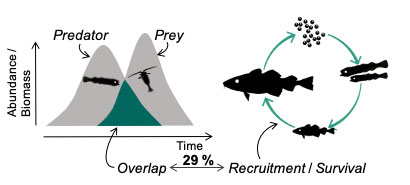From the moment a cod egg is released until it enters the fishery (called recruitment, at 3 years old), a wide range of processes affects its survival. One of these processes is the ability to find food at the right time and place. The match-mismatch hypothesis states that the match (or mismatch) between the timing of the period when larvae feed on its prey and the timing of the prey peak production determines fish survival (Cushing 1990, see post).
In a study published in Marine Ecology Progress Series (Ferreira et al. 2020), we used data on four stages of Gadus morhua larvae and their corresponding prey stages of Calanus finmarchicus collected in the Norwegian−Barents Sea via ichthyoplankton surveys from 1959−1992 to assess the impacts of match-mismatch dynamics on cod recruitment. We used the data to develop a statistical model that quantified the spatio-temporal distribution of each larval stage and species as a function of temperature. We then calculate the spatio-temporal overlap between predator and prey as described in Durant at al (2005). We quantified the spatio-temporal overlap through time from 1959−1992 and compared that with cod recruitment (when they enter the fisheries at 3 years of age).
We found that recruitment of the Northeast Arctic cod is indeed positively and significantly correlated with the spatio-temporal overlap between cod larvae of all size classes (except 21+ mm) and their prey. The results of this analysis thus act as proof of concept and as a step to developing novel statistical methods to identify robust phenology metrics that consider space and describe the overlap in any trophic coupling.
Our improved predator−prey overlap metric is thus (1) useful to better understand how predator−prey dynamics at early life stages of fish impact the survival of later stages (see also the post); and (2) a valuable tool for assessing the state of an ecosystem (see also the post).
References:
Ferreira ASA, Stige LC, Neuheimer AB, Bogstad B, Yaragina N, Prokopchuk I, Durant JM (2020) Match-mismatch dynamics in the Norwegian-Barents Sea system. Marine Ecology Progress Series LFC:LFCav5
Cushing DH (1990) Plankton production and year-class strength in fish populations - an update of the match/mismatch hypothesis. Advances in Marine Biology 26:249-293
Durant JM, Hjermann DO, Anker-Nilssen T, Beaugrand G, Mysterud A, Pettorelli N, Stenseth NC (2005) Timing and abundance as key mechanisms affecting trophic interactions in variable environments. Ecology Letters 8:952-958

Log in to comment
Not UiO or Feide account?
Create a WebID account to comment